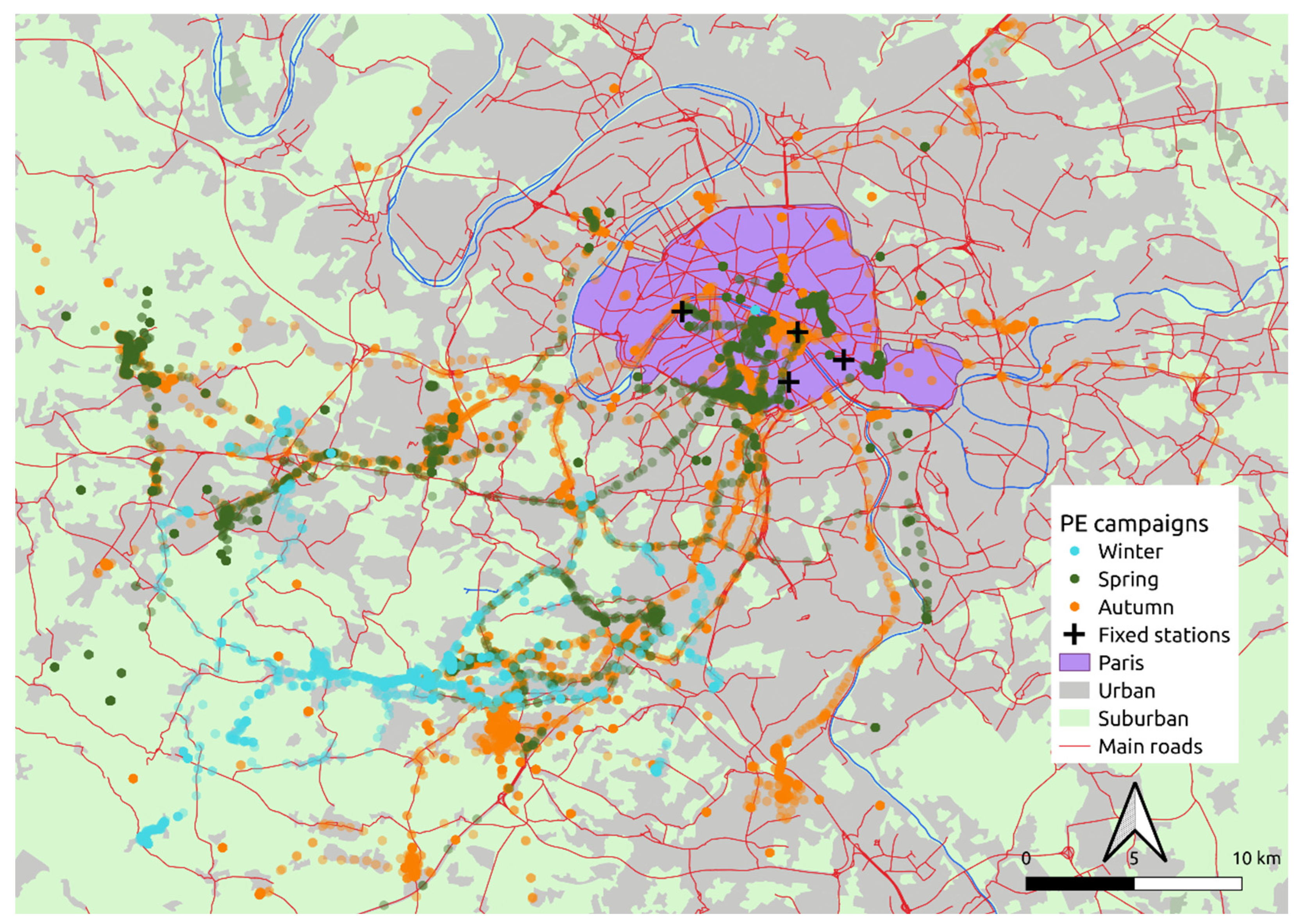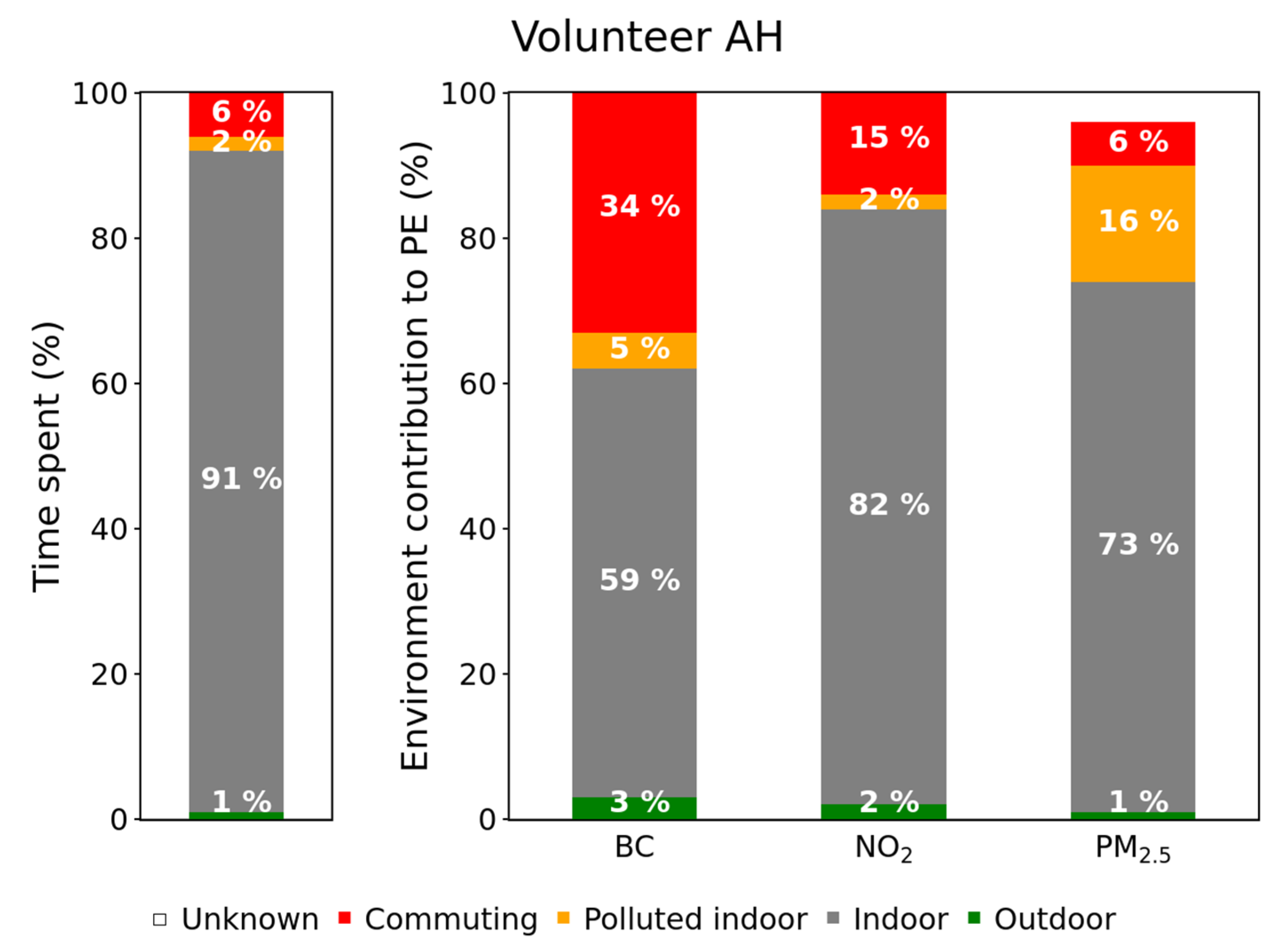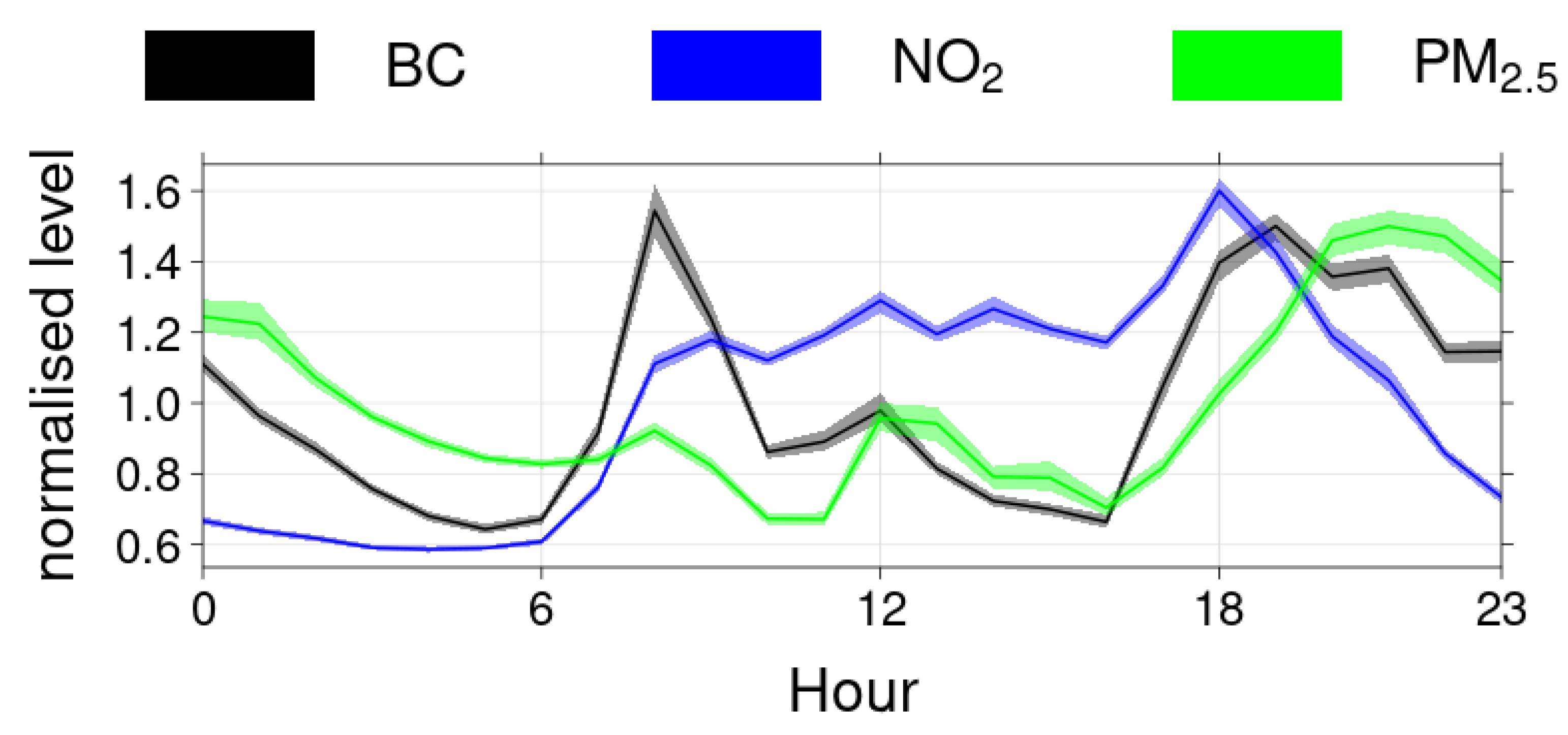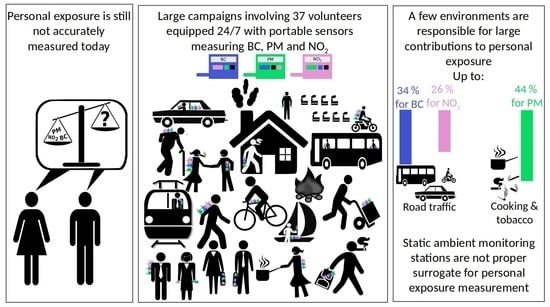Personal Exposure to Black Carbon, Particulate Matter and Nitrogen Dioxide in the Paris Region Measured by Portable Sensors Worn by Volunteers
Abstract
:1. Introduction
2. Materials and Methods
2.1. Characterization of the Sensors
2.2. Presentation of the Three Measurement Campaigns
2.3. Data Invalidation
3. Results
3.1. Overview of the Three Campaign Results and Comparison with Other Studies
3.2. Environments: Characterization and Contribution to PE
3.3. Temporal Variability of PE and Correlation with Urban Background Levels
4. Discussion and Conclusions
Supplementary Materials
Author Contributions
Funding
Institutional Review Board Statement
Informed Consent Statement
Data Availability Statement
Acknowledgments
Conflicts of Interest
References
- Castell, N.; Dauge, F.R.; Schneider, P.; Vogt, M.; Lerner, U.; Fishbain, B.; Broday, D.; Bartonova, A. Can commercial low-cost sensor platforms contribute to air quality monitoring and exposure estimates? Environ. Int. 2017, 99, 293–302. [Google Scholar] [CrossRef]
- Schneider, P.; Castell, N.; Vogt, M.; Dauge, F.R.; Lahoz, W.A.; Bartonova, A. Mapping urban air quality in near real-time using observations from low-cost sensors and model information. Environ. Int. 2017, 106, 234–247. [Google Scholar] [CrossRef]
- Ezani, E.; Masey, N.; Gillespie, J.; Beattie, T.K.; Shipton, Z.K.; Beverland, I.J. Measurement of diesel combustion-related air pollution downwind of an experimental unconventional natural gas operations site. Atmos. Environ. 2018, 189, 30–40. [Google Scholar] [CrossRef]
- Velasco, E.; Tan, S.H. Particles exposure while sitting at bus stops of hot and humid Singapore. Atmos. Environ. 2016, 142, 251–263. [Google Scholar] [CrossRef]
- Kamboures, M.A.; Rieger, P.L.; Zhang, S.; Sardar, S.B.; Chang, M.C.O.; Huang, S.M.; Dzhema, I.; Fuentes, M.; Benjamin, M.T.; Hebert, A.; et al. Evaluation of a method for measuring vehicular PM with a composite filter and a real-time BC instrument. Atmos. Environ. 2015, 123, 63–71. [Google Scholar] [CrossRef]
- Jerrett, M.; Donaire-Gonzalez, D.; Popoola, O.; Jones, R.; Cohen, R.C.; Almanza, E.; Nazelle, A.; Mead, I.; Carrasco-Turigas, G.; Cole-Hunter, T.; et al. Validating novel air pollution sensors to improve exposure estimates for epidemiological analyses and citizen science. Environ. Res. 2017, 158, 286–294. [Google Scholar] [CrossRef]
- Markowicz, K.; Ritter, C.; Lisok, J.; Makuch, P.; Stachlewska, I.; Cappelletti, D.; Mazzola, M.; Chilinski, M. Vertical variability of aerosol single-scattering albedo and equivalent black carbon concentration based on in-situ and remote sensing techniques during the iAREA campaigns in Ny-Ålesund. Atmos. Environ. 2017, 164, 431–447. [Google Scholar] [CrossRef] [Green Version]
- Ostro, B.; Hu, J.; Goldberg, D.; Reynolds, P.; Hertz, A.G.; Bernstein, L.; Kleeman, M.J. Associations of Mortality with Long-Term Exposures to Fine and Ultrafine Particles, Species and Sources: Results from the California Teachers Study Cohort. Environ. Health Health Perspect. 2015, 123, 549–556. [Google Scholar] [CrossRef]
- Castell, N.; Schneider, P.; Grossberndt, S.; Fredriksen, M.; Sousa-Santos, G.; Vogt, M.; Bartonova, A. Localized real-time information on outdoor air quality at kindergartens in Oslo, Norway using low-cost sensor nodes. Environ. Res. 2018, 165, 410–419. [Google Scholar] [CrossRef] [PubMed]
- Park, Y.M.; Sousan, S.; Streuber, D.; Zhao, K. GeoAir—A Novel Portable, GPS-Enabled, Low-Cost Air-Pollution Sensor: Design Strategies to Facilitate Citizen Science Research and Geospatial Assessments of Personal Exposure. Sensors 2021, 21, 3761. [Google Scholar] [CrossRef] [PubMed]
- Hu, K.; Wang, Y.; Rahman, A.; Sivaraman, V. Personalising pollution exposure estimates using wearable activity sensors. In Proceedings of the 2014 IEEE Ninth International Conference on Intelligent Sensors, Sensor Networks and Information Processing (ISSNIP), Singapore, 21–24 April 2014; pp. 1–6. [Google Scholar] [CrossRef] [Green Version]
- Merritt, A.S.; Georgellis, A.; Andersson, N.; Bedada, G.B.; Bellander, T.; Johansson, C. Personal exposure to black carbon in Stockholm, using different intra-urban transport modes. Sci. Total Environ. 2019, 674, 279–287. [Google Scholar] [CrossRef]
- Borghi, F.; Spinazzè, A.; Fanti, G.; Campagnolo, D.; Rovelli, S.; Keller, M.; Cattaneo, A.; Cavallo, D.M. Commuters’ Personal Exposure Assessment and Evaluation of Inhaled Dose to Different Atmospheric Pollutants. Int. J. Environ. Res. Public Health 2020, 17, 3357. [Google Scholar] [CrossRef]
- Kierat, W.; Melikov, A.; Popiolek, Z. A reliable method for the assessment of occupants’ exposure to CO2. Measurement 2020, 163, 108063. [Google Scholar] [CrossRef]
- Johannesson, S.; Gustafson, P.; Molnár, P.; Barregard, L.; Sällsten, G. Exposure to fine particles (PM2.5 and PM1) and black smoke in the general population: Personal, indoor, and outdoor levels. J. Expo. Sci. Environ. Epidemiol. 2007, 17, 613–624. [Google Scholar] [CrossRef] [PubMed]
- Kim, D.; Sass-Kortsak, A.; Purdham, J.T.; Dales, R.E.; Brook, J.R. Associations between personal exposures and fixed-site ambient measurements of fine particulate matter, nitrogen dioxide, and carbon monoxide in Toronto, Canada. J. Expo. Sci. Environ. Epidemiol. 2006, 16, 172–183. [Google Scholar] [CrossRef] [PubMed] [Green Version]
- Lai, H.; Kendall, M.; Ferrier, H.; Lindup, I.; Alm, S.; Hänninen, O.; Jantunen, M.; Mathys, P.; Colvile, R.; Ashmore, M.; et al. Personal exposures and microenvironment concentrations of PM2.5, VOC, NO2 and CO in Oxford, UK. Atmos. Environ. 2004, 38, 6399–6410. [Google Scholar] [CrossRef]
- Chauhan, A.; Inskip, H.M.; Linaker, C.; Smith, S.; Schreiber, J.; Johnston, S.L.; Holgate, S.T. Personal exposure to nitrogen dioxide (NO2) and the severity of virus-induced asthma in children. Lancet 2003, 361, 1939–1944. [Google Scholar] [CrossRef]
- Kierat, W.; Bivolarova, M.; Zavrl, E.; Popiolek, Z.; Melikov, A. Accurate assessment of exposure using tracer gas measurements. Build. Environ. 2018, 131, 163–173. [Google Scholar] [CrossRef] [Green Version]
- Dons, E.; Panis, L.I.; Poppel, M.V.; Theunis, J.; Wets, G. Personal exposure to Black Carbon in transport microenvironments. Atmos. Environ. 2012, 55, 392–398. [Google Scholar] [CrossRef]
- Paunescu, A.C.; Attoui, M.; Bouallala, S.; Sunyer, J.; Momas, I. Personal measurement of exposure to black carbon and ultrafine particles in school children from PARIS cohort (Paris, France). Indoor Air 2017, 27, 766–779. [Google Scholar] [CrossRef]
- Grossberndt, S.; Passani, A.; Di Lisio, G.; Janssen, A.; Castell, N. Transformative Potential and Learning Outcomes of Air Quality Citizen Science Projects in High Schools Using Low-Cost Sensors. Atmosphere 2021, 12, 736. [Google Scholar] [CrossRef]
- Castell, N.; Grossberndt, S.; Gray, L.; Fredriksen, M.; Skaar, J.S.; Høiskar, B.A.K. Implementing citizen science in primary schools: Engaging young children in monitoring air pollution. Front. Clim. 2021, 3, 639128. [Google Scholar] [CrossRef]
- Williams, R.D.; Knibbs, L.D. Daily personal exposure to black carbon: A pilot study. Atmos. Environ. 2016, 132, 296–299. [Google Scholar] [CrossRef] [Green Version]
- Agrawaal, H.; Jones, C.; Thompson, J. Personal exposure estimates via portable and wireless sensing and reporting of particulate pollution. Int. J. Environ. Res. Public Health 2020, 17, 843. [Google Scholar] [CrossRef] [Green Version]
- Milà, C.; Salmon, M.; Sanchez, M.; Ambrós, A.; Bhogadi, S.; Sreekanth, V.; Nieuwenhuijsen, M.; Kinra, S.; Marshall, J.D.; Tonne, C. When, Where, and What? Characterizing Personal PM2.5 Exposure in Periurban India by Integrating GPS, Wearable Camera, and Ambient and Personal Monitoring Data. Environ. Sci. Technol. 2018, 52, 13481–13490. [Google Scholar] [CrossRef] [PubMed] [Green Version]
- Dons, E.; Panis, L.I.; Poppel, M.V.; Theunis, J.; Willems, H.; Torfs, R.; Wets, G. Impact of time–activity patterns on personal exposure to black carbon. Atmos. Environ. 2011, 45, 3594–3602. [Google Scholar] [CrossRef]
- Ma, J.; Tao, Y.; Kwan, M.P.; Chai, Y. Assessing mobility-based real-time air pollution exposure in space and time using smart sensors and GPS trajectories in Beijing. Ann. Am. Assoc. Geogr. 2020, 110, 434–448. [Google Scholar] [CrossRef]
- Liang, L.; Gong, P.; Cong, N.; Li, Z.; Zhao, Y.; Chen, Y. Assessment of personal exposure to particulate air pollution: The first result of City Health Outlook (CHO) project. BMC Public Health 2019, 19, 771. [Google Scholar] [CrossRef] [PubMed] [Green Version]
- Languille, B.; Gros, V.; Bonnaire, N.; Pommier, C.; Honoré, C.; Debert, C.; Gauvin, L.; Srairi, S.; Annesi-Maesano, I.; Chaix, B.; et al. A methodology for the characterization of portable sensors for air quality measure with the goal of deployment in citizen science. Sci. Total Environ. 2020, 708, 134698. [Google Scholar] [CrossRef]
- Delgado-Saborit, J.M. Use of real-time sensors to characterise human exposures to combustion related pollutants. J. Environ. Monit. 2012, 14, 1824–1837. [Google Scholar] [CrossRef]
- Van den Bossche, J.; Peters, J.; Verwaeren, J.; Botteldooren, D.; Theunis, J.; De Baets, B. Mobile monitoring for mapping spatial variation in urban air quality: Development and validation of a methodology based on an extensive dataset. Atmos. Environ. 2015, 105, 148–161. [Google Scholar] [CrossRef] [Green Version]
- Willett, W.; Aoki, P.; Kumar, N.; Subramanian, S.; Woodruff, A. Common Sense Community: Scaffolding Mobile Sensing and Analysis for Novice Users. In International Conference on Pervasive Computing.; Springer: Berlin/Heidelberg, Germany, 2010; Volume 6030, pp. 301–318. [Google Scholar]
- Airparif. Bilan de la qualité de l’air 2019-Surveillance et information en Île-de-France. 2020, pp. 1–98. Available online: https://www.airparif.asso.fr/sites/default/files/documents/2020-06/bilan-2019_0.pdf (accessed on 5 January 2022).
- Zagury, E.; Le Moullec, Y.; Momas, I. Exposure of Paris taxi drivers to automobile air pollutants within their vehicles. Occup. Environ. Med. 2000, 57, 406–410. [Google Scholar] [CrossRef] [PubMed] [Green Version]
- Mosqueron, L.; Momas, I.; Le Moullec, Y. Personal exposure of Paris office workers to nitrogen dioxide and fine particles. Occup. Environ. Med. 2002, 59, 550–555. [Google Scholar] [CrossRef] [Green Version]
- Gelb, J.; Apparicio, P. Modelling Cyclists’ Multi-Exposure to Air and Noise Pollution with Low-Cost Sensors—The Case of Paris. Atmosphere 2020, 11, 422. [Google Scholar] [CrossRef] [Green Version]
- Fishbain, B.; Lerner, U.; Castell, N.; Cole-Hunter, T.; Popoola, O.; Broday, D.M.; Iñiguez, T.M.; Nieuwenhuijsen, M.; Jovasevic- Stojanovic, M.; Topalovic, D.; et al. An evaluation tool kit of air quality micro-sensing units. Sci. Total Environ. 2017, 575, 639–648. [Google Scholar] [CrossRef]
- Schwartz, J.; Dockery, D.W.; Neas, L.M. Is Daily Mortality Associated Specifically with Fine Particles? J. Air Waste Manag. Assoc. 1996, 46, 927–939. [Google Scholar] [CrossRef]
- Petit, J.E.; Favez, O.; Sciare, J.; Crenn, V.; Sarda-Estève, R.; Bonnaire, N.; Mocˇnik, G.; Dupont, J.C.; Haeffelin, M.; Leoz-Garziandia, E. Two years of near real-time chemical composition of submicron aerosols in the region of Paris using an Aerosol Chemical Speciation Monitor (ACSM) and a multi-wavelength Aethalometer. Atmos. Chem. Phys. 2015, 15, 2985–3005. [Google Scholar] [CrossRef] [Green Version]
- Airparif. Bilan de la qualité de l’air 2018-Surveillance et information en Île-de-France. 2019, pp. 1–92. Available online: https://www.airparif.asso.fr/sites/default/files/pdf/bilan-2018.pdf (accessed on 5 January 2022).
- Borghi, F.; Cattaneo, A.; Spinazzè, A.; Manno, A.; Rovelli, S.; Campagnolo, D.; Vicenzi, M.; Mariani, J.; Bollati, V.; Cavallo, D. Evaluation of the inhaled dose across different microenvironments. In IOP Conference Series: Earth and Environmental Science; IOP Publishing: Milan, Italy, 2019; Volume 296, p. 012007. [Google Scholar]
- Pant, P.; Habib, G.; Marshall, J.D.; Peltier, R.E. PM2.5 exposure in highly polluted cities: A case study from New Delhi, India. Environ. Res. 2017, 156, 167–174. [Google Scholar] [CrossRef]
- Ghude, S.D.; Chate, D.M.; Jena, C.; Beig, G.; Kumar, R.; Barth, M.C.; Pfister, G.G.; Fadnavis, S.; Pithani, P. Premature mortality in India due to PM 2.5 and ozone exposure. Geophys. Res. Lett. 2016, 43, 4650–4658. [Google Scholar] [CrossRef] [Green Version]
- Du, X.; Kong, Q.; Ge, W.; Zhang, S.; Fu, L. Characterization of personal exposure concentration of fine particles for adults and children exposed to high ambient concentrations in Beijing, China. J. Environ. Sci. 2010, 22, 1757–1764. [Google Scholar] [CrossRef]
- Harrison, R.; Thornton, C.; Lawrence, R.; Mark, D.; Kinnersley, R.; Ayres, J.G. Personal exposure monitoring of particulate matter, nitrogen dioxide, and carbon monoxide, including susceptible groups. Occup. Env. Med. 2002, 59, 671–679. [Google Scholar] [CrossRef]
- Interieur.gouv.fr. Available online: https://www.interieur.gouv.fr/Publications/Rapports-de-l-IGA/Rapports-recents/Observatoire-de-la-qualite-de-l-air-interieur-Bilan-et-perspectives (accessed on 21 December 2021).
- Klepeis, N.E.; Nelson, W.C.; Ott, W.R.; Robinson, J.P.; Tsang, A.M.; Switzer, P.; Behar, J.V.; Hern, S.C.; Engelmann, W.H. The National Human Activity Pattern Survey (NHAPS): A resource for assessing exposure to environmental pollutants. J. Expo. Anal. Environ. Epidemiol. 2001, 11, 231–252. [Google Scholar] [CrossRef] [Green Version]
- Mills, N.L.; Donaldson, K.; Hadoke, P.W.; Boon, N.A.; MacNee, W.; Cassee, F.R.; Sandström, T.; Blomberg, A.; Newby, D.E. Adverse cardiovascular effects of air pollution. Nat. Clin. Pract. Cardiovasc. Med. 2009, 6, 36–44. [Google Scholar] [CrossRef]
- Languille, B.; Gros, V.; Petit, J.E.; Honoré, C.; Baudic, A.; Perrussel, O.; Foret, G.; Michoud, V.; Truong, F.; Bonnaire, N.; et al. Wood burning: A major source of Volatile Organic Compounds during wintertime in the Paris region. Sci. Total Environ. 2020, 711, 135055. [Google Scholar] [CrossRef] [PubMed]
- Hsu, S.I.; Ito, K.; Kendall, M.; Lippmann, M. Factors affecting personal exposure to thoracic and fine particles and their components. J. Expo. Sci. Environ. Epidemiol. 2012, 22, 439. [Google Scholar] [CrossRef] [PubMed] [Green Version]
- Berthelot, B.; Daoud, A.; Hellio, B.; Akiki, R. Cairsens NO2: A Miniature Device Dedicated to the Indicative Measurement of Nitrogen Dioxide in Ambient Air. Proceedings 2017, 1, 473. [Google Scholar] [CrossRef] [Green Version]
- Airparif.asso.fr. Available online: https://airparif.asso.fr/surveiller-la-pollution/la-pollution-en-direct-en-ile-de-france (accessed on 21 December 2021).





| Campaign | Start–End | Number of Volunteers | Number of Measurements |
|---|---|---|---|
| Spring | 18–22 June 2018 | 16 | 302,506 |
| Autumn | 19–26 November 2018 | 15 | 573,505 |
| Winter | 15 January–17 March 2019 | 6 | 268,605 |
| Study | BC | NO2 | PM1 | PM2.5 | PM10 | |
|---|---|---|---|---|---|---|
| This study | Spring mean (sd) | 1.04 (1.97) | 9 (10) | 5 (10) | 7 (16) | 8 (17) |
| Spring hourly max. | 7.49 | 45 | 311 | |||
| Autumn mean (sd) | 1.68 (1.52) | 9 (12) | 15 (18) | 22 (32) | 24 (36) | |
| Autumn hourly max. | 8.97 | 172 | 490 | |||
| Winter mean (sd) | 0.96 (1.59) | 6 (19) | 8 (19) | 13 (30) | 14 (34) | |
| Winter hourly max. | 11.27 | 39 | 392 | |||
| Other studies | [43] Delhi Win | 22.60 (14.90) | 484 (230) | |||
| [43] Delhi Sum | 3.71 (4.29) | 53,9 (136) | ||||
| [12] Stockholm Spr,Aut,Win | 2.07 (1.62) | |||||
| [24] Brisbane Spr,Aut,Win | 0.60 | |||||
| [31] Birmingham Sum,Aut | 1.30 (2.20) | 23 (50) | ||||
| [17] Oxford year | 15 | |||||
| [18] Southhampton year | 5 | |||||
| [46] Birmingham | 17 | 55 | ||||
| [42] Milan Spr,Aut,Win | 22–37 | 15–42 | ||||
| [45] Pekin Aut | 102.5 | |||||
| [15] Göteborg Aut,Win | 5 |
| Environment | BC (ng·m−3) | NO2 (ppb) | PM2.5 (µg·m−3) | |
|---|---|---|---|---|
| Spring | Commuting | 3722 (1886) | 24 (6) | 6 (1) |
| Polluted indoor | 1555 (803) | 11 (3) | 115 (80) | |
| Indoor | 574 (13) | 9 (2) | 5 (1) | |
| Outdoor | 1986 (960) | 19 (6) | 6 (3) | |
| Autumn | Commuting | 4590 (932) | 21 (7) | 35 (6) |
| Polluted indoor | 3607 (1275) | 11 (6) | 113 (98) | |
| Indoor | 1331 (115) | 8 (3) | 17 (2) | |
| Outdoor | 3178 (379) | 22 (7) | 41 (6) | |
| Winter | Commuting | 2455 (782) | 16 (4) | 11 (8) |
| Polluted indoor | 1937 (1377) | 11 (3) | 53 (47) | |
| Indoor | 542 (539) | 5 (2) | 8 (7) | |
| Outdoor | 1187 (874) | 11 (7) | 15 (17) | |
| Wood burning | 2085 (2104) | 4 (2) | 50 (88) |
| Campaign | Station | Pollutant | 1-h Average | 1-Day Average | ||||||
|---|---|---|---|---|---|---|---|---|---|---|
| rS | rP | In-vol. rS | In-vol. rP | rS | rP | In-vol. rS | In-vol. rP | |||
| Spring | Paris XIIIe | BC | 0.58 | 0.34 | 0.45, 0.74 | 0.23, 0.52 | 0.52 | 0.57 | 0.30, 0.90 | 0.29, 0.97 |
| Paris VIIe | NO2 | 0.27 | 0.26 | 0.21, 0.47 | 0.14, 0.38 | 0.17 | 0.26 | −0.70, 0.60 | −0.49, 0.86 | |
| Paris XIIe | NO2 | 0.13 | 0.14 | 0.07, 0.47 | 0.05, 0.40 | 0.25 | 0.28 | −0.30, 1.00 | −0.24, 0.99 | |
| Paris XIIIe | NO2 | 0.19 | 0.24 | 0.07, 0.50 | 0.10, 0.51 | 0.25 | 0.30 | −0.40, 1.00 | −0.49, 1.00 | |
| Paris IVe | PM2.5 | 0.51 | 0.12 | 0.15, 0.69 | −0.14, 0.68 | 0.64 | 0.41 | −0.20, 1.00 | −0.51, 0.97 | |
| Autumn | Paris XIIIe | BC | 0.71 | 0.54 | 0.67, 0.79 | 0.51, 0.66 | 0.74 | 0.68 | 0.48, 0.95 | 0.49, 0.96 |
| Paris VIIe | NO2 | 0.20 | 0.07 | 0.02, 0.52 | −0.15, 0.49 | 0.07 | 0.02 | −0.38, 0.90 | −0.33, 0.93 | |
| Paris XIIe | NO2 | 0.13 | 0.10 | −0.16, 0.55 | −0.13, 0.64 | 0.10 | 0.17 | −0.94, 0.67 | −0.77, 0.74 | |
| Paris XIIIe | NO2 | 0.15 | 0.06 | −0.07, 0.38 | −0.18, 0.45 | 0.10 | 0.04 | −0.83, 0.62 | −0.83, 0.60 | |
| Paris IVe | PM2.5 | 0.58 | 0.30 | 0.15, 0.88 | 0.00, 0.76 | 0.56 | 0.36 | 0.48, 0.90 | −0.36, 0.94 | |
| Winter | Paris XIIIe | BC | 0.59 | 0.35 | 0.28, 0.77 | 0.07, 0.56 | 0.70 | 0.68 | 0.29, 0.93 | 0.07, 0.92 |
| Paris VIIe | NO2 | 0.16 | 0.23 | −0.08, 0.48 | −0.01, 0.53 | 0.35 | 0.40 | 0.10, 0.80 | 0.18, 0.67 | |
| Paris XIIe | NO2 | 0.07 | 0.15 | −0.17, 0.43 | −0.15, 0.42 | 0.30 | 0.40 | −0.40, 0.71 | −0.05, 0.69 | |
| Paris XIIIe | NO2 | 0.10 | 0.19 | −0.07, 0.38 | −0.04, 0.43 | 0.35 | 0.41 | −0.40, 0.79 | −0.20, 0.65 | |
| Paris IVe | PM2.5 | 0.66 | 0.23 | 0.39, 0.84 | −0.01, 0.79 | 0.55 | 0.38 | −1.00, 0.97 | −1.00, 0.95 | |
Publisher’s Note: MDPI stays neutral with regard to jurisdictional claims in published maps and institutional affiliations. |
© 2022 by the authors. Licensee MDPI, Basel, Switzerland. This article is an open access article distributed under the terms and conditions of the Creative Commons Attribution (CC BY) license (https://creativecommons.org/licenses/by/4.0/).
Share and Cite
Languille, B.; Gros, V.; Nicolas, B.; Honoré, C.; Kaufmann, A.; Zeitouni, K. Personal Exposure to Black Carbon, Particulate Matter and Nitrogen Dioxide in the Paris Region Measured by Portable Sensors Worn by Volunteers. Toxics 2022, 10, 33. https://doi.org/10.3390/toxics10010033
Languille B, Gros V, Nicolas B, Honoré C, Kaufmann A, Zeitouni K. Personal Exposure to Black Carbon, Particulate Matter and Nitrogen Dioxide in the Paris Region Measured by Portable Sensors Worn by Volunteers. Toxics. 2022; 10(1):33. https://doi.org/10.3390/toxics10010033
Chicago/Turabian StyleLanguille, Baptiste, Valérie Gros, Bonnaire Nicolas, Cécile Honoré, Anne Kaufmann, and Karine Zeitouni. 2022. "Personal Exposure to Black Carbon, Particulate Matter and Nitrogen Dioxide in the Paris Region Measured by Portable Sensors Worn by Volunteers" Toxics 10, no. 1: 33. https://doi.org/10.3390/toxics10010033
APA StyleLanguille, B., Gros, V., Nicolas, B., Honoré, C., Kaufmann, A., & Zeitouni, K. (2022). Personal Exposure to Black Carbon, Particulate Matter and Nitrogen Dioxide in the Paris Region Measured by Portable Sensors Worn by Volunteers. Toxics, 10(1), 33. https://doi.org/10.3390/toxics10010033







